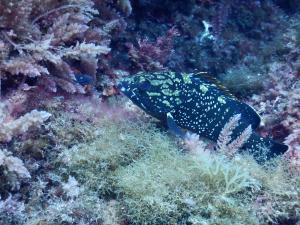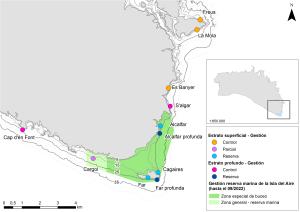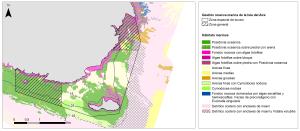The fish populations of the Illa de l’Aire Marine Reserve in Menorca show signs of recovery
- Three years after its declaration as a marine protected area, the results indicate a positive effect of the protection measures adopted.
- However, scientists warn that the new zoning implemented in 2022, which reduces the area of maximum protection, may affect the reserve’s potential for the recovery and conservation of species vulnerable to fishing.

A scientific team from the Jaume Ferrer Research Station at La Mola (Oceanographic Centre of the Balearic Islands, IEO-CSIC) and the Socio-environmental Observatory of Menorca (OBSAM-IME) have just presented the fourth report on the conservation status of fish populations vulnerable to fishing in the marine reserve of l’Illa de l’Aire, declared in Menorca three years ago.
To do so, during 2022, they carried out 99 visual censuses by diving between five and 25 metres deep and identified 21 different species of fish vulnerable to fishing. Comparing these data with those collected since 2018, the scientists have analysed the temporal evolution of biological indicators such as specific richness, abundance (number of individuals) and biomass (weight of individuals) of the populations. These indicators provide a rapid response to the degree of fishing exploitation and make it possible to evaluate the effectiveness of the management measures adopted.
In the surface stratum of the reserve (between five and fifteen metres deep), there has been an increase in abundance and biomass of approximately 50% since the entry into force of the management measures, while outside the protected area none of the indicators have changed during this time, which is evidence of the positive effect of the measures adopted. The results show that the total biomass of fish in the maximum protection area of the reserve is now three times higher than outside it, changes that have also been observed in long-lived and high trophic level species such as grouper. However, the population of this emblematic species is still composed almost entirely of juveniles smaller than the minimum catch size established in the Balearic Islands (45 centimetres), which points to good recruitment and survival in recent years, but is also evidence of the high level of exploitation to which it is subjected.
After four years of monitoring, the results confirm the potential of the Illa de l’Aire marine reserve to host a high diversity, abundance and biomass of species vulnerable to fishing. However, as the scientific team warns in its report, the entry into force of the new zoning in September 2022, which reduces by 22% the area in which artisanal and recreational fishing is prohibited, significantly limits the availability of protected rocky bottoms. “This new zoning has not been established on the basis of scientific criteria and may affect the reserve’s potential for the recovery and conservation of rocky bottom fish stocks vulnerable to fishing,” say the authors.
This project has been developed within the framework of the marine environment monitoring programmes of the Jaume Ferrer de la Mola Research Station and the Socio-environmental Observatory of Menorca, and has the approval of the Directorate General of Fisheries and Marine Environment of the Government of the Balearic Islands. The Jaume Ferrer Station is co-funded by the Directorate General for University Policy and Research and the Spanish Institute of Oceanography. The OBSAM-IME has received funding from Menorca Preservation for the development of the project since its beginning.

